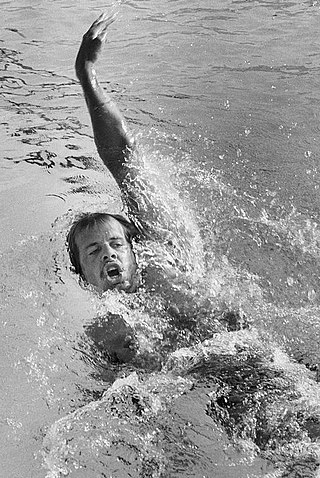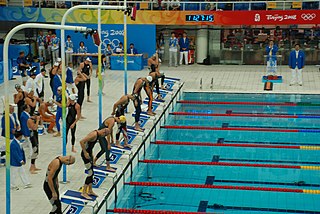Medley is a combination of four different swimming styles—backstroke, breaststroke, butterfly, and freestyle—into one race. This race is either swum by one swimmer as individual medley (IM) or by four swimmers as a medley relay.

Swimming has been a sport at every modern Summer Olympics. It has been open to women since 1912. At the Olympics, swimming has the second-highest number of medal-contested events.

The men's 200 metre backstroke event for the 1976 Summer Olympics was held in Montreal. The event took place on 24 July. There were 33 competitors from 23 nations, with each nation having up to 3 swimmers. The event was won by John Naber of the United States in world-record time; he was the first person to swim the event in under 2 minutes (1:59.19). It was Naber's fifth medal of the Games: completing a double in the backstroke events as well as golds in the medley relay and the 4×200 free relay, along with a silver in the 200 free. It was the second American victory and second American medal sweep in the men's 200 metre backstroke, after 1968; of the 12 medals from 1968 through 1976, 10 were won by Americans and the other two by Roland Matthes. Peter Rocca (silver) and Dan Harrigan (bronze) were the other two Americans, along with Naber, to reach the podium in 1976. The rules changed in 1984 to limit nations to two swimmers each, preventing further sweeps.
This article includes the world record progression for the 4×100 metres medley relay, and it shows the chronological history of world record times in that competitive swimming event. The 4×100 metres medley relay is a medley race in which each of four swimmers on a team swims a 100-metre leg of the relay, each swimming a different stroke, in the following sequence:
- Backstroke ;
- Breaststroke;
- Butterfly;
- Freestyle.

Swimming is an individual or team racing sport that requires the use of one's entire body to move through water. The sport takes place in pools or open water. Competitive swimming is one of the most popular Olympic sports, with varied distance events in butterfly, backstroke, breaststroke, freestyle, and individual medley. In addition to these individual events, four swimmers can take part in either a freestyle or medley relay. A medley relay consists of four swimmers who will each swim a different stroke, ordered as backstroke, breaststroke, butterfly and freestyle.

Freestyle is a category of swimming competition, defined by the rules of the International Swimming Federation (FINA), in which competitors are subject to a few limited restrictions on their swimming stroke. Freestyle races are the most common of all swimming competitions, with distances beginning with 50 meters and reaching 1,500 meters, also known as the mile. The term 'freestyle stroke' is sometimes used as a synonym for 'front crawl', as front crawl is the fastest surface swimming stroke. It is now the most common stroke used in freestyle competitions.
The women's 4 × 100 metre freestyle relay event at the 1952 Olympic Games took place on 30 July and 1 August at the Swimming Stadium. This swimming event used freestyle as a relay, with swimmers typically using the front crawl. Because an Olympic size swimming pool is 50 metres long, each of the four swimmers completed two lengths of the pool. The first swimmer had to touch the wall before the second could leave the starting block; timing of the starts was thus important.

The women's 4 × 100 metre freestyle relay event at the 1956 Olympic Games took place on 4 and 6 December. This swimming event used freestyle as a relay, with swimmers typically using the front crawl. Because an Olympic size swimming pool is 50 metres long, each of the four swimmers completed two lengths of the pool. The first swimmer had to touch the wall before the second could leave the starting block; timing of the starts was thus important.
The men's 4 × 100 metre medley relay event at the 1960 Olympic Games took place on August 27 (qualification) and September 1 (final). This swimming event used medley swimming as a relay. Because an Olympic size swimming pool is 50 metres long, each of the four swimmers completed two lengths of the pool, each using a different stroke. The first on each team used the backstroke, the second used the breaststroke, the third used the butterfly stroke, and the final swimmer used freestyle.
The women's 4 × 100 metre freestyle relay event at the 1960 Olympic Games took place on September 2 and 3, in Rome. This swimming event used freestyle as a relay, with swimmers typically using the front crawl. Because an Olympic size swimming pool is 50 metres long, each of the four swimmers completed two lengths of the pool. The first swimmer had to touch the wall before the second could leave the starting block; timing of the starts was thus important.
The women's 4 × 100 metre medley relay event at the 1960 Olympic Games took place on August 30 (qualification) and September 2 (final). This swimming event uses medley swimming as a relay. Because an Olympic size swimming pool is 50 metres long, each of the four swimmers completed two lengths of the pool, each using a different stroke. The first on each team used the backstroke, the second used the breaststroke, the third used the butterfly stroke, and the final swimmer used freestyle.
The men's 4 × 100 metre medley relay event at the 1964 Olympic Games took place on October 15 (qualification) and October 16 (final). This swimming event uses medley swimming as a relay. Because an Olympic size swimming pool is 50 metres long, each of the four swimmers completed two lengths of the pool, each using a different stroke. The first on each team used the backstroke, the second used the breaststroke, the third used the butterfly stroke, and the final swimmer used freestyle.
The women's 400 metre individual medley event at the 1964 Summer Olympics took place on 15–17 October. This swimming event used medley swimming and this was the first time for this event in this distance for the women swimmers. Because an Olympic size swimming pool is 50 metres long, this race consisted of eight lengths of the pool. The first two lengths were swum using the butterfly stroke, the second pair with the backstroke, the third pair of lengths in breaststroke, and the final two were freestyle. Unlike other events using freestyle, swimmers could not use butterfly, backstroke, or breaststroke for the freestyle leg; most swimmers use the front crawl in freestyle events.

The men's 200 metre freestyle event at the 1968 Olympic Games took place on 24 October at the Alberca Olímpica Francisco Márquez. It was the third time the event was held, returning for the first time since 1904. There were 57 competitors from 26 nations, with each nation having up to three swimmers. The event was won by Michael Wenden of Australia, the nation's second victory in the event ; Australia extended its podium streak in the event to three Games over 68 years. It was Wenden's second gold medal of the Games, completing a 100/200 free double. Americans Don Schollander and John Nelson took silver and bronze, respectively.
The men's 4×100 metre medley relay event at the 1968 Olympic Games took place on October 26. This swimming event uses medley swimming as a relay. Because an Olympic size swimming pool is 50 metres long, each of the four swimmers completed two lengths of the pool, each using a different stroke. The first on each team used the backstroke, the second used the breaststroke, the third used the butterfly stroke, and the final swimmer used freestyle.
The women's 4×100 metre medley relay event at the 1968 Olympic Games took place on 17 October. This swimming event uses medley swimming as a relay. Because an Olympic size swimming pool is 50 metres long, each of the four swimmers completed two lengths of the pool, each using a different stroke. The first on each team used the backstroke, the second used the breaststroke, the third used the butterfly stroke, and the final swimmer used freestyle.

The men's 100 metre freestyle event at the 1972 Olympic Games took place between September 2 and 3. There were 48 competitors from 29 nations. Nations had been limited to three swimmers each since the 1924 Games. The event was won by Mark Spitz of the United States, his then-record sixth gold medal in a single Games. It was the ninth victory in the event for an American, most of any nation. Jerry Heidenreich, also of the United States, took silver. Soviet swimmer Vladimir Bure earned bronze, the nation's first medal in the men's 100 metre freestyle.
The men's 4 × 100 metre medley relay event at the 1972 Olympic Games took place on September 4. This swimming event uses medley swimming as a relay. Because an Olympic size swimming pool is 50 metres long, each of the four swimmers completed two lengths of the pool, each using a different stroke. The first on each team used the backstroke, the second used the breaststroke, the third used the butterfly stroke, and the final swimmer used freestyle.
The women's 4 × 100 metre medley relay event at the 1972 Olympic Games took place on September 3. This swimming event uses medley swimming as a relay. Because an Olympic size swimming pool is 50 metres long, each of the four swimmers completed two lengths of the pool, each using a different stroke. The first on each team used the backstroke, the second used the breaststroke, the third used the butterfly stroke, and the final swimmer used freestyle.
Freya Ann Alexandra Anderson is a British swimmer, known primarily for her achievements as a freestyle sprinter, especially as a relay swimmer for Great Britain. Anderson achieved nine relay gold medals at three editions of the European Championships, including 5 golds in a single meet at the 2020 European Championships in Budapest, as well as two bronze medals at the Commonwealth Games and a bronze at the 2019 World Aquatics Championships. In July 2021, she won gold as part of the British team at the 2020 Tokyo Olympics in mixed 4 × 100 metre medley relay, swimming the freestyle anchor leg in the heat.







